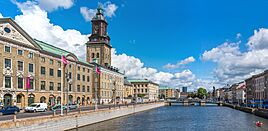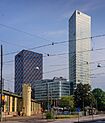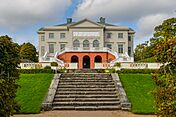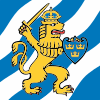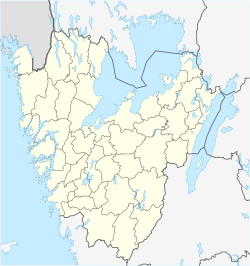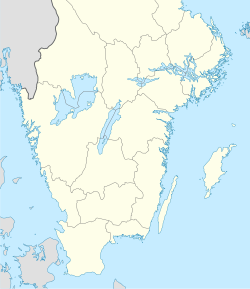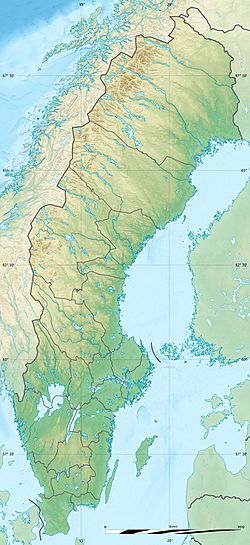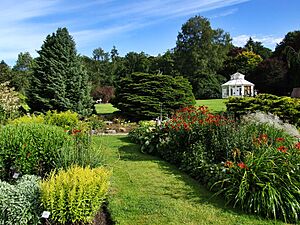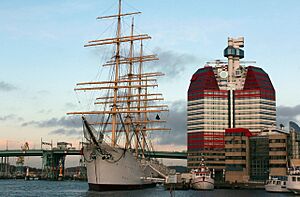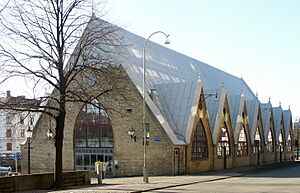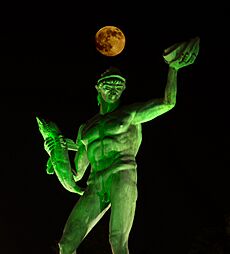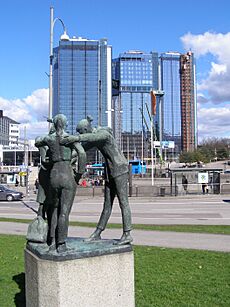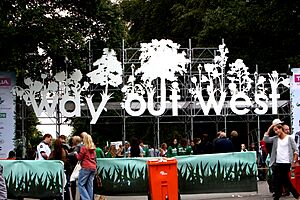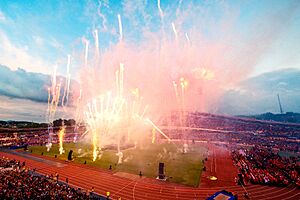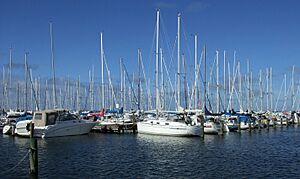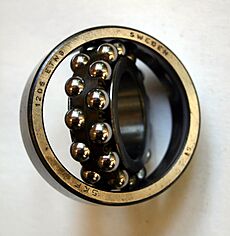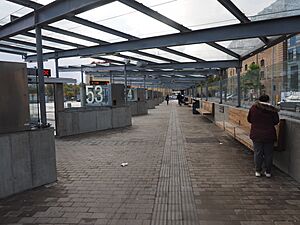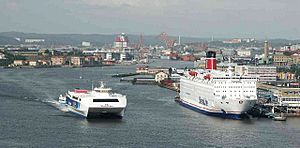Gothenburg facts for kids
Quick facts for kids
Gothenburg
Göteborg
|
|||
|---|---|---|---|
|
City
|
|||
|
Museum of Gothenburg and German Church in Nordstaden
Garden Society
Skyscrapers in Gårda
Skansen Lejonet
Feskekôrka building
Karlatornet
Gunnebo Castle
|
|||
|
|||
| Country | |||
| Province | Västergötland, Bohuslän and Halland | ||
| County | Västra Götaland County | ||
| Municipality | Gothenburg Municipality | ||
| Charter | 1621 | ||
| Area | |||
| • City | 447.76 km2 (172.88 sq mi) | ||
| • Water | 14.5 km2 (5.6 sq mi) 3.2% | ||
| • Urban | 203.67 km2 (78.64 sq mi) | ||
| • Metro | 3,694.86 km2 (1,426.59 sq mi) | ||
| Elevation | 12 m (39 ft) | ||
| Population
(2023)
|
|||
| • City | 604,616 | ||
| • Density | 1,350.313/km2 (3,497.29/sq mi) | ||
| • Metro | 1,080,980 | ||
| Demonym(s) | Göteborgare/Gothenburger | ||
| GDP | |||
| • Metro | €79.086 billion (2021) | ||
| • Per capita | €73,400 (2021) | ||
| Time zone | UTC+1 (CET) | ||
| • Summer (DST) | UTC+2 (CEST) | ||
| Postal code |
40xxx – 41xxx – 421xx – 427xx
|
||
| Area code(s) | (+46) 31 | ||
| Website |
|
||
Gothenburg (pronounced GOTH-en-burg; abbreviated Gbg; in Swedish: Swedish: Göteborg) is a major city in Sweden. It's the second-largest city in Sweden, right after the capital Stockholm. It's also the fifth-largest city in the Nordic countries.
Gothenburg is located on the west coast of Sweden, by the Kattegat sea. About 600,000 people live in the city itself, and around 1.1 million live in the wider metropolitan area.
King Gustavus Adolphus officially founded Gothenburg in 1621. He wanted it to be a strong trading port. Many Dutch, German, and Scottish people helped build and settle the city. The Port of Gothenburg is now the biggest port in the Nordic countries.
Gothenburg is home to the University of Gothenburg and Chalmers University of Technology, so it has many students. Famous companies like Volvo (founded in 1927), AstraZeneca, Ericsson, and SKF have their roots or major operations here.
The city hosts big events like the Gothia Cup, which is the world's largest youth football tournament. It also has the Göteborg Basketball Festival, Europe's biggest youth basketball tournament. The Gothenburg Film Festival is a leading film festival in Scandinavia. Many music festivals, like the Way Out West Festival, also happen here.
Contents
- City Name: Why Two Names?
- History: Building a Trading City
- Geography: Where is Gothenburg?
- Parks and Nature: Green Spaces to Explore
- Architecture: Old and New Buildings
- Culture: Fun and Entertainment
- Economy: Trade and Industry
- Education: Universities and Schools
- Transport: Getting Around
- Famous People from Gothenburg
- International Recognition
- Images for kids
- See also
City Name: Why Two Names?
The city was named Göteborg in its official document in 1621. At the same time, it was given the German and English name Gothenburg. The Swedish name comes from the Göta älv (Göta River) and other cities ending in -borg.
Both the Swedish and German/English names were used even before 1621. Gothenburg is one of the few Swedish cities that still has an official and widely used name in other languages.
Many people from the Netherlands, Scotland, England, and Germany helped build and trade in Gothenburg. Because of this, the name Gothenburg (or similar versions) was used in their languages. Even today, you might see both "Gothenburg" and "Göteborg" used, for example, by the University of Gothenburg.
In 2009, the city council tried a new logo for Gothenburg. They changed the Swedish letter "ö" to "o:" to make the name look more international. So, you might see "Go:teborg" on signs around the city.
History: Building a Trading City
Gothenburg was very important because it was Sweden's only way to the North Sea and Atlantic Ocean. It was located in a narrow strip of Swedish land between Danish and Norwegian territories. After a few tries, King Gustavus Adolphus successfully founded the city in 1621.
The first church in Gothenburg was built in 1603 but was destroyed by Danish invaders in 1611. You can find a stone marking its spot near the Älvsborg Bridge.
The city was greatly influenced by the Dutch, Germans, and Scots. Dutch planners were hired to build the city because they knew how to build in marshy (swampy) areas. The city's design, with its streets and canals, was similar to Dutch cities like Amsterdam. For a while, Dutch politicians even had a lot of power in Gothenburg. Strong city walls were built in the 1600s, but most were torn down in 1807.
Scottish settlers also played a big role. William Chalmers, whose father was Scottish, used his money to start what became the Chalmers University of Technology. In 1841, another Scotsman, Alexander Keiller, started the Götaverken shipbuilding company.
The Gothenburg coat of arms shows a lion holding a shield with the Three Crowns, which is Sweden's national symbol. This shows the city's role in defending the country.
In 1658, Sweden gained more land from Denmark and Norway, making Gothenburg less exposed to attacks. The city grew into a major port and trade center. It was one of the few cities on the west coast allowed to trade with other countries.
In the 1700s, fishing was important, but the city really boomed when the Swedish East India Company was founded in 1731. This company made huge profits from trade with China.
Gothenburg became the main port for Swedes leaving to live in the United States. This is why there's even a small Swedish settlement called Gothenburg, Nebraska in the US!
In the 1800s and 1900s, Gothenburg became a modern industrial city. Its population grew from 13,000 in 1800 to 130,000 in 1900. Big companies like SKF (1907) and Volvo (1927) started here.
Geography: Where is Gothenburg?
Gothenburg is on Sweden's west coast, about halfway between Copenhagen (Denmark) and Oslo (Norway). Its location at the mouth of the Göta älv river, which flows into the Kattegat (part of the North Sea), has helped it become an important trading city.
The Gothenburg archipelago is made up of rocky islands and cliffs, which is typical for this coast. Thanks to the Gulf Stream, Gothenburg has a mild climate and gets a fair amount of rain.
The larger Gothenburg area, called Stor-Göteborg, has over 1 million people. It includes several nearby towns and municipalities.
Some parts of Gothenburg, like Angered and Bergsjön, are suburbs built as part of a program in the 1960s and 70s. Hisingen is a large island that is part of Gothenburg, separated from the main city by the river.
Climate: Mild Weather Year-Round
Gothenburg has an oceanic climate, meaning it has mild temperatures throughout the year. This is because of the Gulf Stream, which brings warmer water from the Atlantic. Even though it's far north, it's warmer than some places at the same latitude, like Stockholm.
Summers are warm and pleasant, with average high temperatures around 20 to 22 °C (68 to 72 °F). It often gets hotter, reaching 25–30 °C (77–86 °F). Winters are cold and windy, with temperatures usually between −1 to 4 °C (30 to 39 °F). It rarely drops below −20 °C (−4 °F). Rain is common throughout the year, but it's usually not too heavy. Snow mostly falls from December to March.
Parks and Nature: Green Spaces to Explore
Gothenburg has many beautiful parks and nature reserves. These green areas range from small city parks to large natural spaces.
Here are some of the notable parks:
- Kungsparken: This park surrounds the canal that circles the city center. It was built between 1839 and 1861.
- Garden Society of Gothenburg: This park has a famous rose garden with about 4,000 roses. It was started in 1842.
- Slottsskogen: A large park with a free "open" zoo. You can see animals like seals, penguins, and moose here. The Natural History Museum is also in this park. The annual Way Out West festival is held here.
- Änggårdsbergens naturreservat: A large nature reserve that was given to the city in 1963. It's meant to stay a nature and bird reserve.
- Gothenburg Botanical Garden: Opened in 1923, this garden is considered one of the most important botanical gardens in Europe. It has about 16,000 types of plants and trees. Its greenhouses contain around 4,500 species, including 1,600 orchids.
Architecture: Old and New Buildings

Not many buildings from the 1600s (when the city was founded) are left, because most were made of wood. Some old buildings that still stand include Kronhuset and the Torstenson Palace, and the fortresses Skansen Kronan and Skansen Lejonet.
In the 1700s, when the East India Company made Gothenburg a rich trading city, grand stone houses in a Neo-Classical style were built around the canals. The East India House, which is now the Göteborg City Museum, is an example.
In the 1800s, wealthy people started moving outside the city walls. The style of buildings became more decorative. Working-class people lived in wooden houses in crowded areas like Haga.
The main street, Kungsportsavenyen (often called Avenyn), was built in the 1800s. A unique type of house called Landshövdingehusen was built at the end of the 19th century. These are three-story houses with the first floor made of stone and the top two of wood.
The early 1900s saw the National Romantic style, with buildings like Masthugg Church. In the 1920s, for the city's 300th anniversary, the Götaplatsen square with its Neoclassical look was built.
Later, Functionalism became popular, especially in suburbs like Västra Frölunda. In the 1950s, the big Ullevi stadium was built for the 1958 FIFA World Cup.
Modern architects like Gert Wingårdh have shaped the city's newer buildings.
Gustaf Adolf Square is a central town square. Important buildings there include Gothenburg City Hall and the law court.
Characteristic Buildings: Landmarks of Gothenburg
The Gothenburg Central Station is in the city center. It has been updated many times since it opened in 1858. Near the station is the Skanskaskrapan, also known as "The Lipstick." This 86 m (282 ft) tall skyscraper has 22 floors and is red and white.
By the Göta Älv river, you'll find The Göteborg Opera. It was finished in 1994. Its architect was inspired by the landscape, wanting it to look like "the wings of a seagull."
Feskekörka, or Fiskhallen, is an indoor fish market. It opened in 1874 and got its name because it looks like a Gothic church. The Gothenburg city hall is built in the Beaux-Arts style. The Gothenburg Synagogue was built in 1855.
The Gunnebo House is a country house south of Gothenburg, built in a neoclassical style in the late 1700s. The Vasa Church, built in the early 1900s, is made of granite in a neo-Romanesque style.
Another interesting structure is the Brudaremossen TV Tower, which is one of the few partially guyed towers in the world.
Culture: Fun and Entertainment
Gothenburg's culture is shaped by its history of sea trade and industry. It's also a popular place for tourists on Sweden's west coast.
Museums: Learning and Exploring
Many of Gothenburg's cultural places, like museums and universities, were started with money donated by rich merchants. The Museum of World Culture opened in 2004. Other museums include the Göteborgs Konsthall (art gallery), Gothenburg Museum of Art, and museums about sea history, natural history, and science.
The Volvo museum shows the history of Volvo cars, trucks, and engines from 1927 until today.
Universeum is a public science center that opened in 2001. It's the largest of its kind in Scandinavia. It has different sections with hands-on workshops and collections of reptiles, fish, and insects.
Leisure and Entertainment: Things to Do
The most famous attraction is the Liseberg amusement park. It's the largest amusement park in Scandinavia and one of the top ten in the world. Over 3 million people visit it each year, making it the most popular attraction in Sweden.
Gothenburg has many theater groups, including the Gothenburg City Theatre.
The main street is called Kungsportsavenyn, or Avenyn (The Avenue). It's about 1 km (0.6 mi) long. It starts at Götaplatsen, where you'll find the Gothenburg Museum of Art, the city's theater, and the concert hall. Avenyn has the most pubs and clubs in Gothenburg. The city's largest shopping center, Nordstan, is also in central Gothenburg.
Gothenburg's Haga district is famous for its charming wooden houses and cafes. They serve the Haga bulle, a large cinnamon roll.
Gothenburg has many top chefs, and several restaurants have received stars in the Michelin Guide.
A popular natural attraction is the southern Gothenburg archipelago. These islands can be reached by ferry from Saltholmen. You can visit places like the Älvsborg fortress and Vinga island.
Festivals and Fairs: Big Events
The annual Gothenburg Film Festival is the biggest film festival in Scandinavia. The Gothenburg Book Fair, held every September, is the largest literary festival in Scandinavia.
The International Science Festival in Gothenburg is an annual event with science activities for the public. It attracts about 100,000 visitors each year, making it one of the biggest science events in Europe.
Music: A City of Sounds
Gothenburg has a lively music scene. The Gothenburg Symphony Orchestra is well-known for classical music. The first internationally successful Swedish group, The Spotnicks, was from Gothenburg.
Pop bands like The Soundtrack of Our Lives and Ace of Base are from here. In the 1970s, Gothenburg was a center for Swedish progressive music.
There's also a strong indie music scene. Artists like Jens Lekman, The Knife, José González, and Little Dragon are from Gothenburg. Håkan Hellström, one of Sweden's most popular singers, often sings about places in the city.
Gothenburg is famous for pioneering melodic death metal with bands like At the Gates, In Flames, and Dark Tranquillity. Other metal bands from the city include The Haunted and HammerFall.
Many music festivals happen in the city every year. The Metaltown Festival featured heavy metal bands. The Way Out West festival focuses on rock, electronic, and hip-hop.
Sports: A Passion for Games
Like all of Sweden, people in Gothenburg enjoy many sports, including football, ice hockey, basketball, and handball.
Gothenburg is where football in Sweden began, with the first match played here in 1892. The city's three main football clubs, IFK Göteborg, Örgryte IS, and GAIS, have won many Swedish championships. IFK Göteborg has also won the UEFA Cup twice! Other important clubs include BK Häcken (football) and Frölunda HC (ice hockey).
The city's main sports venues are Scandinavium and Ullevi (for many sports), and the newer Gamla Ullevi (for football).
Gothenburg has hosted many international sports events. These include the 1958 FIFA World Cup, the 1992 European Football Championship, and the 1995 World Championships in Athletics.
The annual Gothia Cup is the world's largest football tournament for young people. In 2011, over 35,000 players from 1,567 teams and 72 countries took part! The Göteborgsvarvet is also a very popular annual half marathon.
Sailing is a popular sport because of the nearby Gothenburg archipelago, with many sailboats and yachts around the city. Gothenburg has hosted major sailing events like the Volvo Ocean Race.
Economy: Trade and Industry
Gothenburg's location has always made trade and shipping very important to its economy. The Gothenburg port is the largest harbor in Scandinavia.
Besides trade, manufacturing and industry have traditionally been key to Gothenburg's wealth. Big companies like SKF, Volvo (cars and trucks), and Ericsson have factories here. Volvo Cars is the largest employer in Gothenburg. While older industries are still important, new high-tech industries are growing.
Banking, finance, and the tourism industry are also important parts of the city's economy.
Historically, Gothenburg was home to the Swedish East India Company in the 1700s. Until the late 1970s, the city was a world leader in shipbuilding. Gothenburg is considered a "global city" and has been ranked as one of the most inventive cities in the world by Forbes.
Education: Universities and Schools
Gothenburg has two main universities:
- The University of Gothenburg: This is one of the largest universities in Scandinavia, with about 38,000 students. It offers a wide range of subjects.
- Chalmers University of Technology: This is a well-known university focusing on technology.
The city also has many high schools. Some are even connected to big Swedish companies like SKF and Volvo. There are also several adult education centres.
Transport: Getting Around
Gothenburg has a large tram network that covers most of the city. It's the biggest tram system in Scandinavia. The city also has a bus network. Boats and ferry services connect the Gothenburg archipelago to the mainland. There isn't a subway because the ground in Gothenburg is very soft, making tunnels expensive to build.
The Gothenburg commuter rail connects the city to nearby towns. There's also a ferry line, Älvsnabben, that operates on the Göta älv river.
Rail and Intercity Bus: Travel Far
The main train station is Centralstationen (Gothenburg Central Station). The Nils Ericson Terminal is where buses leave for many places in Sweden, and also to Oslo and Copenhagen.
Air: Flying In and Out
Gothenburg is served by Göteborg Landvetter Airport (GOT). It's about 20 km (12 mi) east of the city center. It's Sweden's second-largest airport. You can take a bus from the airport to Gothenburg.
The smaller Göteborg City Airport (GSE) used to serve low-cost airlines but closed for commercial flights in 2015.
Sea: Ferries to Other Countries
The Swedish company Stena Line operates ferries from Gothenburg to Frederikshavn in Denmark and Kiel in Germany. There are also cargo ships that leave from the port to North America and East Asia.
Famous People from Gothenburg
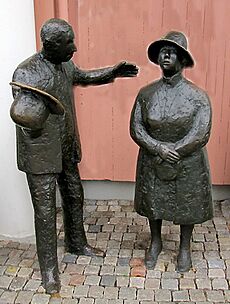
Two famous people from Gothenburg are actually fictional characters: Kal and Ada. They are a working-class couple known from "Gothenburg jokes" and songs. A bronze statue of them stands outside the entrance to Liseberg. Each year, two people who have helped the city's culture are given honorary "Kal and Ada" titles.
Other notable people from Gothenburg include:
- Evert Taube (1890–1976), a famous Swedish author, artist, and singer.
- Victor Hasselblad (1906–1978), who invented the famous Hasselblad cameras.
- Björn Ulvaeus (born 1945), a singer-songwriter from the legendary group ABBA.
- Håkan Hellström (born 1974), a very popular Swedish singer-songwriter.
- Alicia Vikander (born 1988), an Academy Award-winning actress.
- Felix Kjellberg (born 1989), a famous YouTuber.
- In Flames (formed 1990), a well-known heavy metal band.
Sports Stars
- Gunnar Gren (1920–1991), a legendary footballer.
- Daniel Alfredsson (born 1972), a professional ice hockey player and Hall of Fame member.
- Henrik Stenson (born 1976), a golfer who won the British Open.
- Lucas Raymond (born 2002), a professional ice hockey player.
International Recognition
Gothenburg is recognized internationally for its efforts in sustainability and smart tourism.
- The Global Destination Sustainability Index has named Gothenburg the world's most sustainable destination every year since 2016.
- In 2019, the EU chose Gothenburg as one of the top European Capitals of Smart Tourism.
The Gothenburg Award is a special international prize given to people who work for sustainable development. Past winners include Kofi Annan and Al Gore.
Sister Cities
Gothenburg is twinned with several cities around the world, meaning they have special friendly relationships:
Images for kids
See also
 In Spanish: Gotemburgo para niños
In Spanish: Gotemburgo para niños


